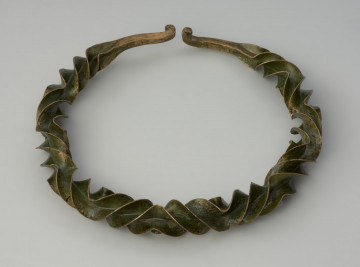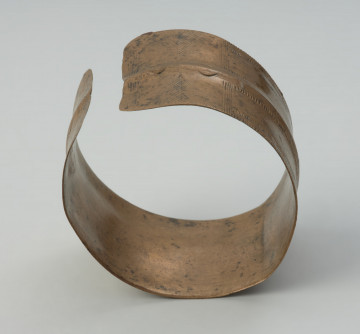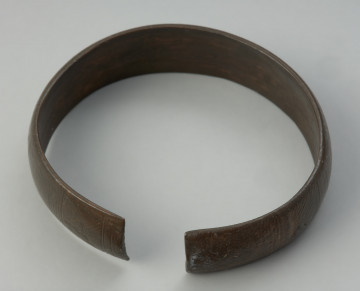
Wendelring necklace
around 600 p.n.e. — 400 p.n.e.
National Museum in Szczecin
Part of the collection: Bronze Age
The hoop is made from a square tin bar. It has straight-cut and slightly thickened ends and small holes in several places. The specific cracks on the surface and the deformation prove secondary burning. The hoop is part of a hoard trove of bronze ornaments that Karl Sager, a farmer, found in his meadow in 1941. A drawing made by Captain Poirot, a prisoner of the Prenzlau POW camp, shows that the original arrangement of the discovered objects was not accidental. Five spiral bracelets were strung on two wreath necklaces, and a tin hoop was laid over all this. The water context and the intentional arrangement indicate that this was a sacrificial deposit. The find was transferred to the collection of the Pommersches Landesmuseum in Stettin (Polish: Pomorskie Muzeum Krajowe w Szczecinie; English: Pomeranian State Museum in Szczecin). It stayed there for only three years. In 1944, it was evacuated in its entirety deep into Germany, where it was hidden from wartime destruction. The artefacts returned to Szczecin in 2009 due to the Polish-German exchange of former archaeological collections. The tin hoop is a rare find in Poland. Its occurrence is limited to the Hallstatt period D (approx. 600/550-400/450 BC). The remaining impressive objects from the treasure are testimony to the exceptional skills of prehistoric metallurgists. The great value of the exhibition and the excellent preservation of these artefacts make it possible to regard the deposit from Karkowo as one of the most valuable museum acquisitions.
Dorota Kozłowska
Author / creator
Dimensions
the entire object: height: 1 cm
Object type
secondary raw material, necklace, bangle (hoop), body adornment
Technique
bending
Material
tin
Origin / acquisition method
legal transfer
Creation time / dating
Creation / finding place
Owner
National Museum in Szczecin
Identification number
Location / status

around 600 p.n.e. — 400 p.n.e.
National Museum in Szczecin

around 1200 p.n.e. — 1000 p.n.e.
National Museum in Szczecin

around 1200 p.n.e. — 1000 p.n.e.
National Museum in Szczecin
DISCOVER this TOPIC
Museum of King Jan III's Palace at Wilanów
DISCOVER this PATH
Educational path